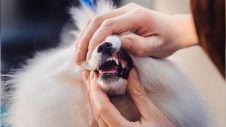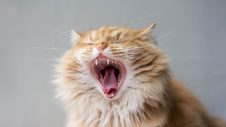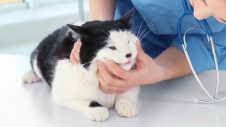Smelly pet breath isn’t normal
While many people believe that bad breath is normal for their furry friends, it can be an indication of a dental problem. Proper dental care for pets is critical to your pet’s overall health and well-being. Dental disease, if left untreated or undetected, can cause pain, discomfort and bacteria, which could contribute to heart, liver, and kidney health problems.
The good news is, in most cases, dental disease is preventable with regular dental examinations and the appropriate ongoing dental care. There are things you can do at home to ensure your pet’s teeth are in top condition. Having a dental health check at your local Greencross Vets will give you and your pet a good starting point.
What is dental disease?
Dental disease, or periodontal disease, is inflammation of the teeth and gums caused by a build-up of plaque. Plaque, which is made up of food particles, saliva, and bacteria, sticks to the tooth surface and, if not removed, will calcify into tartar.
This build-up occurs both above and below the gum line and, over time, can lead to gingivitis and the destruction of the supportive tissues of the teeth, including the gums and bone. This results in bad breath, oral pain, and tooth loss. Dental disease is painful for pets, but they can’t tell us that it hurts.
Around 80% of cats and dogs over the age of three are suffering from some form of dental disease.
The signs of dental disease
- Bad breath
- Discoloured teeth
- Loose teeth
- Excessive drooling
- Blood-stained or inflamed gums
- Dropping of food from the mouth when eating, or reluctance to chew or eat at all
- Pain when handled around the head
- Facial swelling
- Behavioural changes (e.g. lethargy, increased aggression)
- Pawing at the mouth
- Receding gums.
Click here to view our pet dental grading chart
How do I prevent dental disease?
For adult cats and dogs with existing dental disease, a scale and polish from your veterinarian is often necessary. This will allow us to start their prevention plan with a fresh, clean mouth.
Tips to prevent dental disease
Brush their teeth
Brushing your pet’s teeth daily can help control the build-up of plaque that leads to dental disease.
Selecting a toothbrush
- Specially-made dog and cat toothbrushes are available to purchase.
- Toddler toothbrushes are great for cats and small dogs.
- Electric toothbrushes are easy to use and efficient. However, your pet may be frightened by the noise.
- Make sure you label your pet’s toothbrush and keep it separate from the family toothbrushes.
Selecting a toothpaste
- Do not use human toothpaste when brushing your pet’s teeth, as it can upset their stomach.
- Special pet toothpastes in flavours like chicken or beef are available.
Introducing your pet to teeth brushing
Cats and small dogs may feel more comfortable if they can sit on their owner’s lap while having their teeth brushed.
- Begin slowly. Initial sessions should be kept brief.
- Get your pet used to the toothbrush by dipping it in tuna juice, chicken stock or beef stock.
- Offer your pet a taste of special pet toothpaste to get them used to it.
- When your pet is comfortable with the brush, try brushing one or two strokes on a few teeth. Slowly increase the brushing as your pet becomes more comfortable.
- Start at the front of the mouth. Pets are often more accepting of this.
Five steps to effective teeth brushing
- Add toothpaste – apply a small amount of pet toothpaste to the brush (do not use human toothpaste).
- Correct angle – hold the brush at a 45-degree angle to the gum line.
- Circular motion – apply the toothbrush and use a circular motion with gentle pressure on the teeth and gum line.
- Brush for 30 to 60 seconds – brush for at least 30 seconds on each side of the mouth, remembering the back teeth.
- Reward – reward your pet for their good behaviour.
Alternatives to teeth brushing
Treats and chews
Large, hard products such as pig’s ears, noses and trotters, rawhide bones, and Dentabones encourage your pets to chew. The chewing action aids in the removal of plaque via physical rubbing and the spread of protective saliva. These should not be relied on solely for dental prevention, as they are not as effective as raw bones, but they could be fed once a week instead of raw bones as a change for your pet.
Dental diets
Premium dry pet foods and special dental treats are available for cats and dogs. They’re specially designed to keep pets’ teeth clean while providing them with their nutritional needs. These foods contain enzymes and ingredients similar to those found in our toothpaste, which help slow dental disease and prevent plaque from forming on the teeth. Some premium pet food brands offer a money-back guarantee if you or your pet aren’t satisfied (ask your Greencross Vet).
If your pet hasn’t started these specially designed foods at an early age, it is best to start them after their teeth have been professionally scaled and polished.
Oral and Dental Treatments
For pets with severe or persistent dental and gum disease or bad breath, using a rinse or gel from your veterinary clinic may be advisable. Gum protectant applications may also be prescribed for pets with problem gums.
Dental Toys
There are some toys available that are great at encouraging your pet to chew. Some of these toys include the ‘Kong’ and ‘Gumabone’.Toys are a useful addition to a dental hygiene program; however, they should not be relied on solely.
Veterinary Dental Treatments
In the majority of pet’s lives, there comes a time when their teeth may require professional veterinary treatment. Treatment involves a full dental examination while your pet is under anaesthetic, including scaling (both ultrasonically and by hand) and polishing. Your veterinarian may perform dental x-rays (radiographs) to view the roots of the teeth and other pathology which can help detect disease hidden under the gum line. The procedure is similar to what you would have experienced at your own dentist.
What should I do if I suspect my pet has dental disease?
If you’re worried your pet may be developing dental disease, take them to your vet for a proper diagnosis. It’s always best to get a professional opinion. Your Greencross Vet will help you to develop the best dental plan tailored to your pet.

 Greencross Vets
Greencross Vets 










